Effect of Temperature on Diluate Water in Batch Electrodialysis Reversal
Abstract
:1. Introduction
2. Materials and Methods
2.1. Study Area and Preparation of Feed Water
2.2. System CIP
2.3. Description of the Electrodialysis Equipment
2.4. Limiting Current Density Tests
2.5. Setup of EDR Experiments
2.6. Operation of EDR Equipment
2.7. Process Control Parameters
3. Results and Discussion
3.1. Characteristics of Well Water
3.2. Limiting Current Density Test Results
3.3. Effect of Applied Voltage (10 and 20 V)
3.4. Evaluation of the Effect of Temperature on Removal Efficiency
3.5. Comparison with NOM-127 Standards
3.6. Energy Demand of the Process
3.7. Water Cost Evaluation
4. Conclusions
Author Contributions
Funding
Institutional Review Board Statement
Informed Consent Statement
Data Availability Statement
Acknowledgments
Conflicts of Interest
Abbreviations
| Variables | Description | Units |
| TDS | Total dissolved solids | mg/L |
| BW | Brackish water | mg/L |
| T-1 | Diluate tank | L |
| T-2 | Electrode waste tank | L |
| T-3 | Concentrate tank | L |
| P-1, P-2 and P-3 | Centrifugal pump | HP |
| R-1, R-2 and R-3 | Rotameter | L/min |
| LCD | Limiting current density | mA/cm2 |
| PIE | Percentage of ions extracted | % |
| TDSi | Concentration of salts in feed water | mg/L |
| TDSf | Concentration of the diluate tank at the end of the experiment | mg/L |
| R% | Recovery percentage | % |
| QD | Diluate flow rate | L/min |
| QF | Feed flow rate | L/min |
| QC | Concentrate flow rate | L/min |
| D | Diluate salinity | mg/L, mEq/L |
| C | Concentrate salinity | mg/L, mEq/L |
| CFE | Federal Electricity Commission | |
| NOM-127-SSA1-1994 | Official Mexican standard | |
| ED | Electrodialysis | |
| EDR | Electrodialysis reversal | |
| AEM | Anion exchange membrane | |
| CEM | Cation exchange membrane | |
| Diffusion coefficient | m2/s | |
| Flux | mol/s | |
| Concentration | mol/m3 | |
| Charge number | ||
| Faraday number | C/mol | |
| Gas constant | J/mol-K | |
| Absolute temperature | K | |
| Voltage | V | |
| vi | Ion mobility | m2/s-V |
| i | Component | |
| V-1, V-2, V-3, V-4, V-5 | Shut-on valves | |
| V-6, V-7, V-8, V-9, V-10 | Shut-off valves |
Appendix A
| Time (min) | 10 V | 20 V | ||||||
|---|---|---|---|---|---|---|---|---|
| Diluate Water | Concentrated Water | Diluate Water | Concentrated Water | |||||
| EC (mS/cm) | TDS (mg/L) | EC (mS/cm) | TDS (mg/L) | EC (mS/cm) | TDS (mg/L) | EC (mS/cm) | TDS (mg/L) | |
| 0 | 3.14 | 2020.55 | 3.14 | 2020.55 | 3.15 | 2031.50 | 3.15 | 2028.60 |
| 4 | 2.63 | 1695.33 | 3.31 | 2128.42 | 2.03 | 1309.25 | 3.77 | 2426.16 |
| 7 | 2.30 | 1477.98 | 3.73 | 2404.37 | 1.51 | 974.37 | 4.41 | 2842.62 |
| 10 | 1.92 | 1234.87 | 3.96 | 2548.31 | 0.95 | 613.09 | 4.76 | 3066.94 |
| 13 | 1.51 | 970.19 | 4.31 | 2775.96 | 0.57 | 367.72 | 5.12 | 3298.57 |
| 16 | 1.18 | 757.67 | 4.78 | 3080.90 | 0.39 | 285.94 | 5.32 | 3426.72 |
| 19 | 0.92 | 589.26 | 5.15 | 3319.18 | 0.22 | 142.97 | 5.50 | 3541.36 |
| Time (min) | 10 V | 20 V | ||||||
|---|---|---|---|---|---|---|---|---|
| Diluate Water | Concentrated Water | Diluate Water | Concentrated Water | |||||
| EC (mS/cm) | TDS (mg/L) | EC (mS/cm) | TDS (mg/L) | EC (mS/cm) | TDS (mg/L) | EC (mS/cm) | TDS (mg/L) | |
| 0 | 3.12 | 2009.28 | 3.12 | 2009.28 | 3.12 | 2010.25 | 3.11 | 2005.85 |
| 4 | 2.45 | 1575.87 | 3.29 | 2115.54 | 2.14 | 1374.94 | 3.58 | 2303.37 |
| 7 | 2.05 | 1317.62 | 3.65 | 2351.89 | 1.63 | 1046.50 | 4.32 | 2780.58 |
| 10 | 1.79 | 1150.51 | 4.06 | 2612.06 | 0.83 | 592.48 | 4.77 | 3071.45 |
| 13 | 1.53 | 878.09 | 4.35 | 2799.79 | 0.57 | 366.01 | 5.02 | 3232.45 |
| 16 | 1.04 | 667.83 | 4.59 | 2955.64 | 0.40 | 257.92 | 5.39 | 3469.44 |
| 19 | 0.85 | 545.15 | 4.77 | 3070.27 | 0.21 | 136.85 | 5.53 | 3564.11 |
| Time (min) | 10 V | 20 V | ||||||
|---|---|---|---|---|---|---|---|---|
| Diluate Water | Concentrated Water | Diluate Water | Concentrated Water | |||||
| EC (mS/cm) | TDS (mg/L) | EC (mS/cm) | TDS (mg/L) | EC (mS/cm) | TDS (mg/L) | EC (mS/cm) | TDS (mg/L) | |
| 0 | 3.11 | 1999.62 | 3.11 | 1999.62 | 3.14 | 2023.13 | 3.14 | 2021.73 |
| 4 | 2.13 | 1374.62 | 3.48 | 2242.09 | 1.84 | 1181.74 | 3.66 | 2356.40 |
| 7 | 1.73 | 1115.73 | 3.96 | 2548.63 | 1.40 | 902.24 | 4.29 | 2763.40 |
| 10 | 1.35 | 869.40 | 4.27 | 2752.78 | 0.89 | 570.58 | 4.76 | 3066.94 |
| 13 | 0.88 | 565.75 | 4.59 | 2954.99 | 0.56 | 360.64 | 5.04 | 3244.90 |
| 16 | 0.68 | 435.67 | 4.82 | 3103.44 | 0.31 | 200.28 | 5.28 | 3398.39 |
| 19 | 0.57 | 366.44 | 5.06 | 3257.67 | 0.18 | 116.56 | 5.39 | 3468.37 |
| Time (min) | 10 V | 20 V | ||||||
|---|---|---|---|---|---|---|---|---|
| Diluate Water | Concentrated Water | Diluate Water | Concentrated Water | |||||
| EC (mS/cm) | TDS (mg/L) | EC (mS/cm) | TDS (mg/L) | EC (mS/cm) | TDS (mg/L) | EC (mS/cm) | TDS (mg/L) | |
| 0 | 7.86 | 5064.63 | 7.86 | 5064.63 | 7.79 | 5015.15 | 7.79 | 5015.15 |
| 4 | 6.83 | 4397.45 | 7.93 | 5104.56 | 5.74 | 3697.20 | 8.24 | 5307.53 |
| 7 | 6.22 | 4008.69 | 8.48 | 5462.19 | 4.95 | 3185.22 | 9.56 | 6157.61 |
| 10 | 5.65 | 3641.18 | 8.94 | 5756.29 | 3.75 | 2415.64 | 10.53 | 6781.32 |
| 13 | 4.86 | 3126.83 | 9.46 | 6091.17 | 2.78 | 1788.39 | 11.41 | 7344.82 |
| 16 | 4.25 | 2738.29 | 9.86 | 6351.56 | 2.05 | 1319.23 | 12.10 | 7792.40 |
| 19 | 3.75 | 2414.14 | 10.33 | 6651.45 | 0.97 | 623.39 | 12.78 | 8230.32 |
| Time (min) | 10 V | 20 V | ||||||
|---|---|---|---|---|---|---|---|---|
| Diluate Water | Concentrated Water | Diluate Water | Concentrated Water | |||||
| EC (mS/cm) | TDS (mg/L) | EC (mS/cm) | TDS (mg/L) | EC (mS/cm) | TDS (mg/L) | EC (mS/cm) | TDS (mg/L) | |
| 0 | 7.82 | 5038.44 | 7.82 | 5038.44 | 7.70 | 4958.16 | 7.69 | 4954.72 |
| 4 | 6.33 | 4073.51 | 8.39 | 5401.87 | 5.00 | 3218.39 | 8.84 | 5693.39 |
| 7 | 5.80 | 3733.05 | 9.16 | 5897.97 | 3.93 | 2528.99 | 10.33 | 6654.67 |
| 10 | 4.92 | 3168.05 | 9.90 | 6374.53 | 2.79 | 1799.66 | 11.38 | 7326.57 |
| 13 | 4.19 | 2700.51 | 10.61 | 6832.84 | 1.93 | 1241.63 | 12.25 | 7889.00 |
| 16 | 3.48 | 2240.48 | 11.15 | 7182.75 | 1.25 | 807.90 | 12.69 | 8174.51 |
| 19 | 2.93 | 1889.07 | 11.60 | 7468.25 | 0.81 | 520.35 | 13.14 | 8464.31 |
| Time (min) | 10 V | 20 V | ||||||
|---|---|---|---|---|---|---|---|---|
| Diluate Water | Concentrated Water | Diluate Water | Concentrated Water | |||||
| EC (mS/cm) | TDS (mg/L) | EC (mS/cm) | TDS (mg/L) | EC (mS/cm) | TDS (mg/L) | EC (mS/cm) | TDS (mg/L) | |
| 0 | 7.81 | 5027.71 | 7.81 | 5029.00 | 7.80 | 5021.27 | 7.79 | 5015.90 |
| 4 | 6.28 | 4046.47 | 8.31 | 5348.42 | 4.92 | 3167.84 | 9.04 | 5823.48 |
| 7 | 5.36 | 3454.20 | 9.45 | 6087.95 | 3.16 | 2034.07 | 10.32 | 6643.50 |
| 10 | 4.33 | 2785.51 | 10.51 | 6766.29 | 2.29 | 1472.18 | 11.61 | 7474.69 |
| 13 | 3.39 | 2181.01 | 11.06 | 7124.79 | 1.62 | 1045.21 | 12.33 | 7938.37 |
| 16 | 2.65 | 1709.18 | 11.83 | 7616.59 | 1.14 | 733.19 | 12.93 | 8326.92 |
| 19 | 1.79 | 1155.55 | 12.42 | 7998.48 | 0.79 | 506.18 | 13.50 | 8696.15 |
References
- Marshall, S.J. Hydrology. In Reference Module in Earth Systems and Environmental Sciences; Elsevier: Amsterdam, The Netherlands, 2013. [Google Scholar] [CrossRef]
- Rijsberman, F.R. Water scarcity: Fact or fiction? Agric. Water Manag. 2006, 80, 5–22. [Google Scholar] [CrossRef] [Green Version]
- Comisión Nacional Del Agua. In Estadísticas del Agua en México, 2017 ed.; Secretaria de Medio Ambiente y Recursos Naturales: Mexico City, Mexico, 2017; p. 291.
- Medina, M.R.; Saavedra, R.M.; Montaño, M.M.; Gurrola, J.C. Vulnerabilidad a la intrusión marina de acuíferos costeros en el Pacífico Norte Mexicano; un caso, el acuífero costa de Hermosillo, Sonora, México. Rev. Lat.-Am. Hidrogeol. 2002, 2, 31–52. [Google Scholar] [CrossRef]
- Rodríguez-López, J.; Robles-Lizárraga, A.; Encinas-Guzmán, M.I.; Correa-Díaz, F.; Dévora-Isiordia, G.E. Assessment of fixed, single-axis, and dual-axis photovoltaic systems applied to a reverse osmosis desalination process in northwest Mexico. Desalination Water Treat. 2021, 234, 399–407. [Google Scholar] [CrossRef]
- Monreal, R.; Castillo, J.; Rangel, M.; Morales, M.; Oroz, L.A.; Valenzuela, H. La intrusión salina en el acuífero de la costa de hermosillo, Sonora. In Proceedings of the Acta de Sesiones de la XXIV Convención Internacional de la Asociación de Ingenieros de Minas Metalurgistas y Geólogos de México, Acapulco, Mexico, 17–20 October 2001; pp. 93–98. [Google Scholar]
- Gillam, W.S.; McCoy, W.H. Desalination Research and Water Resources. Princ. Desalination 1967, 2, 1–20. [Google Scholar] [CrossRef]
- Robles-Lizárraga, A.; Martínez-Macías, M.d.R.; Encinas-Guzmán, M.I.; Larraguibel-Aganza, O.d.J.; Rodríguez-López, J.; Dévora-Isiordia, G.E. Design of reverse osmosis desalination plant in Puerto Peñasco, Sonora, México. Desalination Water Treat. 2020, 175, 1–10. [Google Scholar] [CrossRef]
- Belessiotis, V.; Kalogirou, S.; Delyannis, E. Chapter one—Desalination methods and technologies—Water and energy. In Thermal Solar Desalination; Academic Press: Cambridge, MA, USA, 2016; pp. 1–19. [Google Scholar] [CrossRef]
- Ruan, G.; Wang, M.; An, Z.; Xu, G.; Ge, Y.; Zhao, H. Progress and Perspectives of Desalination in China. Membranes 2021, 11, 206. [Google Scholar] [CrossRef]
- Strathmann, H. Chapter one—Overview of ion-exchange membrane processes. In Membrane Science and Technology; Elsevier: Amsterdam, The Netherlands, 2004; Volume 9, pp. 1–22. [Google Scholar] [CrossRef]
- Strathmann, H. Assessment of electrodialysis water desalination process costs. In Proceedings of the International Conference on Desalination Costing, Limassol, Cyprus, 6 December 2004; pp. 32–54. [Google Scholar]
- Katz, W.E. The electrodialysis reversal (EDR) process. Desalination 1979, 28, 31–40. [Google Scholar] [CrossRef]
- Armendariz-Ontiveros, M.M.; Álvarez-Sánchez, J.; Dévora-Isiordia, G.E.; García, A.; Fimbres Weihs, G.A.; Dévora-Isiordia, G.E. Effect of seawater variability on endemic bacterial biofouling of a reverse osmosis membrane coated with iron nanoparticles (FeNPs). Chem. Eng. Sci. 2020, 223, 115753. [Google Scholar] [CrossRef]
- Baker, R.W. Ion Exchange membrane processes—Electrodialysis. In Membrane Technology and Applications; John Wiley & Sons: Hoboken, NJ, USA, 2004; pp. 393–423. [Google Scholar]
- Encinas-Guzmán, M.I.; Robles-Lizárraga, A.; Rodríguez-López, J.; Dévora-Isiordia, G.E. Economic evaluation of reverse osmosis brine evaporation: Environmental management in Mexico. Rev. Int. Contam. Ambient. 2021, 37, 319–327. [Google Scholar]
- Honarparvar, S.; Zhang, X.; Chen, T.; Alborzi, A.; Afroz, K.; Reible, D. Frontiers of Membrane Desalination Processes for Brackish Water Treatment: A Review. Membranes 2021, 11, 246. [Google Scholar] [CrossRef]
- Strathmann, H. Chapter 2 electrochemical and thermodynamic fundamentals. In Membrane Science and Technology; Elsevier: Amsterdam, The Netherlands, 2004; Volume 9, pp. 23–88. [Google Scholar] [CrossRef]
- Marder, L.; Pérez Herranz, V. Electrodialysis control parameters. In Electrodialysis and Water Reuse, 1st ed.; Springer: Berlin/Heidelberg, Germany, 2014; pp. 25–39. [Google Scholar] [CrossRef]
- Mavrov, V.; Pusch, W.; Kiminek, O.; Wheelwrigth, S. Concentration polarization and water splitting at electrodialysis membranes. Desalination 1993, 91, 225–252. [Google Scholar] [CrossRef]
- Benneker, A.M.; Klomp, J.; Lammertink, R.G.H.; Wood, J.A. Influence of temperature gradients on mono- and divalent ion transport in electrodialysis at limiting currents. Desalination 2018, 443, 62–69. [Google Scholar] [CrossRef]
- Onuki, K. Electro-electrodialysis of hydriodic acid in the presence of iodine at elevated temperature. J. Memb. Sci. 2001, 192, 193–199. [Google Scholar] [CrossRef]
- López-García, U.; Antaño-López, R.; Orozco, G.; Torres-González, J.; Castañeda, F. Comparison on Nine Membrane Pairs for Electrodialytic Removal of Nitrate Ions. J. Water Resour. Prot. 2011, 3, 387–397. [Google Scholar] [CrossRef] [Green Version]
- Kucera, J. Basic terms and definitions. In Reverse Osmosis; John Wiley & Sons, Inc.: Hoboken, NJ, USA, 2015; pp. 25–48. [Google Scholar]
- Singh, R. Desalination and on-site energy for groundwater treatment in developing countries using fuel cells. In Emerging Membrane Technology for Sustainable Water Treatment; Elsevier: Amsterdam, The Netherlands, 2016; pp. 135–162. [Google Scholar]
- Walker, W.S.; Kim, Y.; Lawler, D.F. Treatment of model inland brackish groundwater reverse osmosis concentrate with electrodialysis—Part II: Sensitivity to voltage application and membranes. Desalination 2014, 345, 128–135. [Google Scholar] [CrossRef]
- Gherasim, C.-V.; Křivčík, J.; Mikulášek, P. Investigation of batch electrodialysis process for removal of lead ions from aqueous solutions. Chem. Eng. J. 2014, 256, 324–334. [Google Scholar] [CrossRef]
- Amor, Z.; Malki, S.; Taky, M.; Bariou, B.; Mameri, N.; Elmidaoui, A. Optimization of fluoride removal from brackish water by electrodialysis. Desalination 1998, 120, 263–271. [Google Scholar] [CrossRef]
- Banasiak, L.J.; Kruttschnitt, T.W.; Schäfer, A.I. Desalination using electrodialysis as a function of voltage and salt concentration. Desalination 2007, 205, 38–46. [Google Scholar] [CrossRef] [Green Version]
- Galama, A.H.; Saakes, M.; Bruning, H.; Rijnaarts, H.H.M.; Post, J.W. Seawater predesalination with electrodialysis. Desalination 2014, 342, 61–69. [Google Scholar] [CrossRef]
- NOM-127-SSA1-1994, Salud Ambiental. Agua para uso y consumo humano. Límites permisibles de calidad y tratamientos a que debe someterse el agua para su potabilización. In Diario Oficial de la Federación; Secretaría de Salud: Mexico City, Mexico, 2000. [Google Scholar]
- Leitz, F.B.; Accomazzo, M.A.; McRae, W.A. High temperature electrodialysis. Desalination 1974, 14, 33–41. [Google Scholar] [CrossRef]
- Dévora-Isiordia, G.E.; González-Enríquez, R.; Ruiz-Cruz, S. Evaluación de procesos de desalinización y su desarrollo en México. Tecnol. Cienc. Agua 2013, 4, 27–46. [Google Scholar]
- CFE. Tarifas. Available online: https://app.cfe.mx/Aplicaciones/CCFE/Tarifas/Tarifas/tarifas_casa.asp (accessed on 15 April 2021).
- Karagiannis, I.C.; Soldatos, P.G. Water desalination cost literature: Review and assessment. Desalination 2008, 223, 448–456. [Google Scholar] [CrossRef]
- Al-Amshawee, S.; Yunus, M.Y.B.M.; Azoddein, A.A.M.; Hassell, D.G.; Dakhil, I.H.; Hasan, H.A. Electrodial-ysis desalination for water and wastewater: A review. Chem. Eng. J. 2020, 380, 122231. [Google Scholar] [CrossRef]
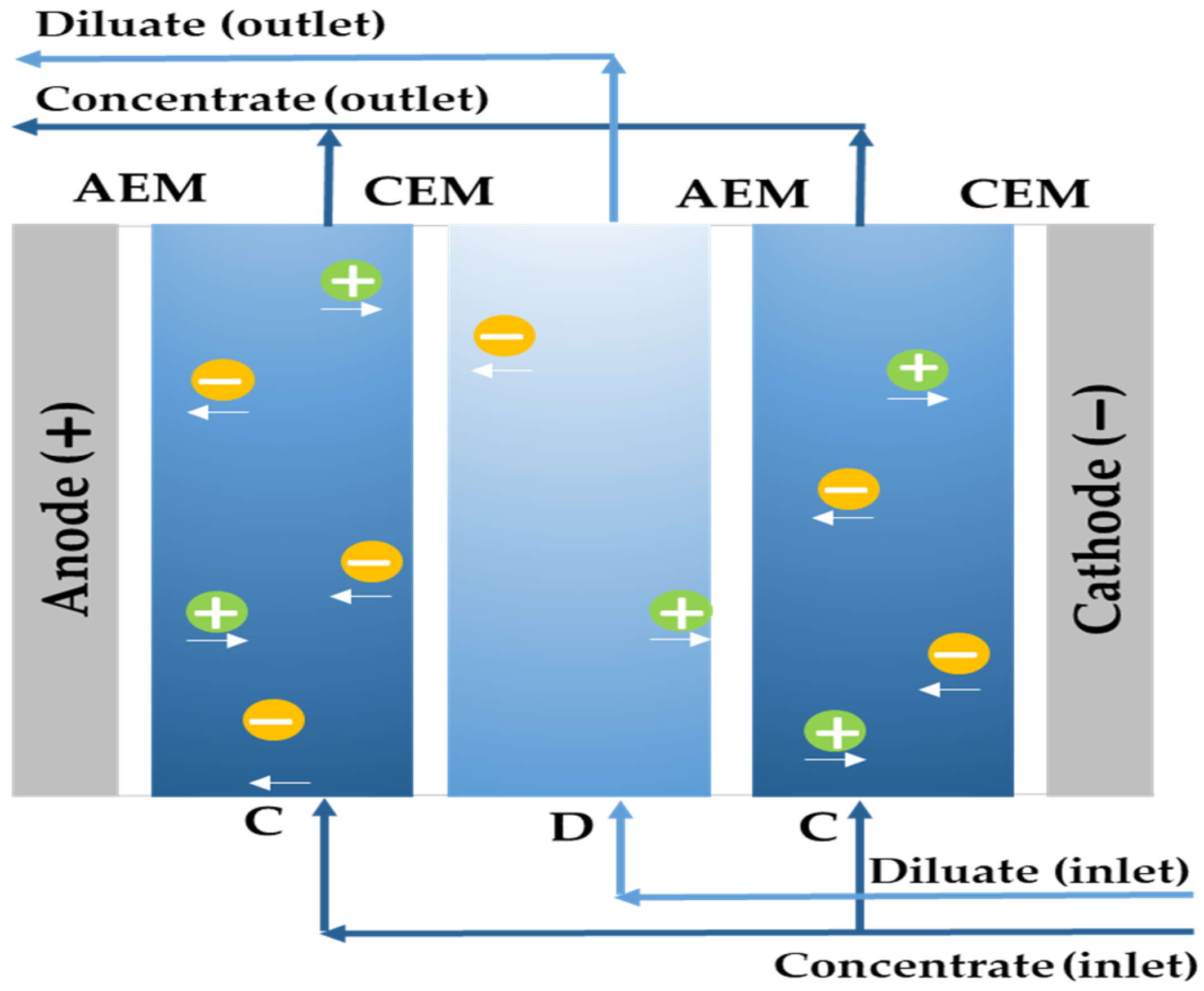
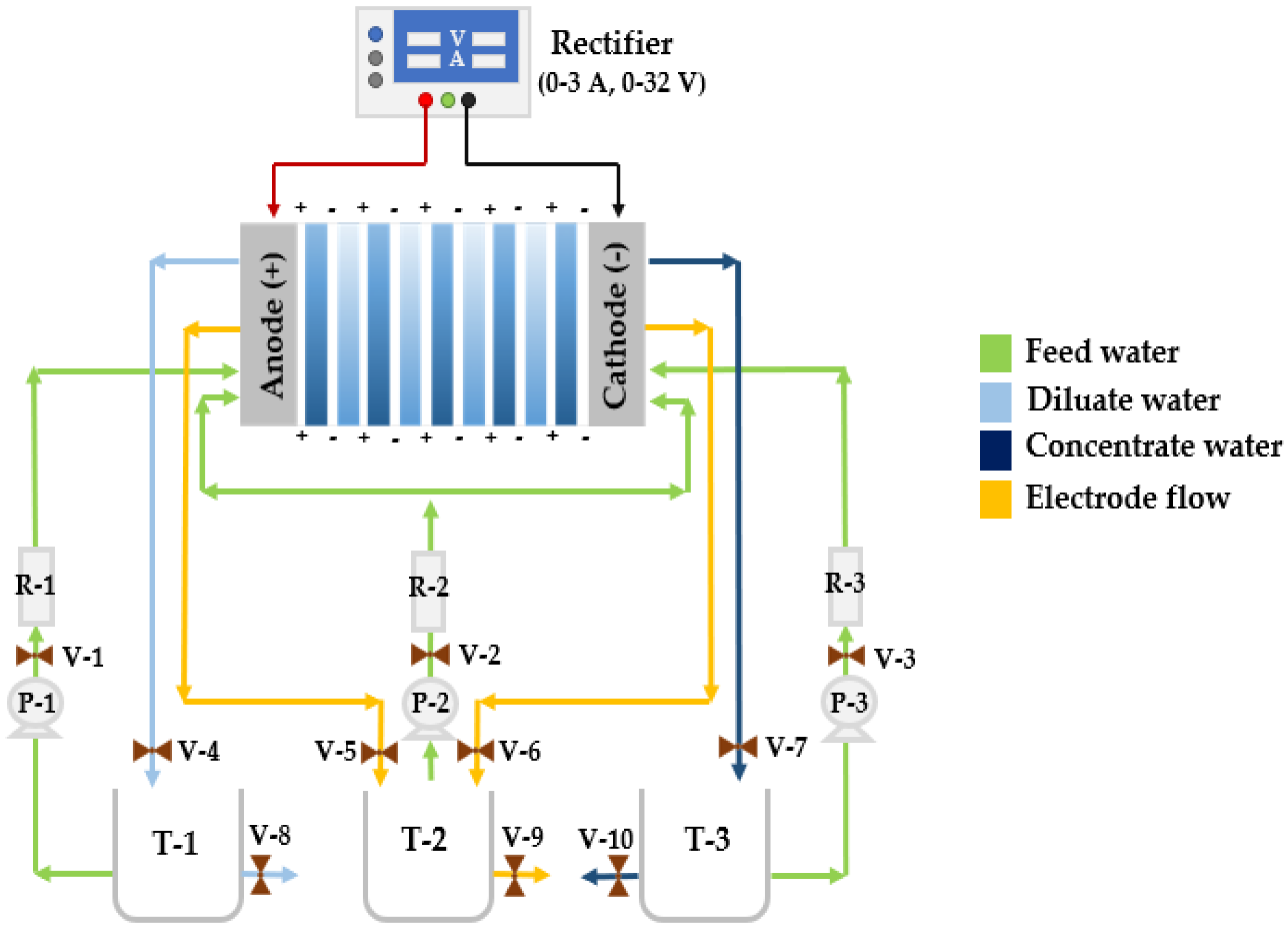



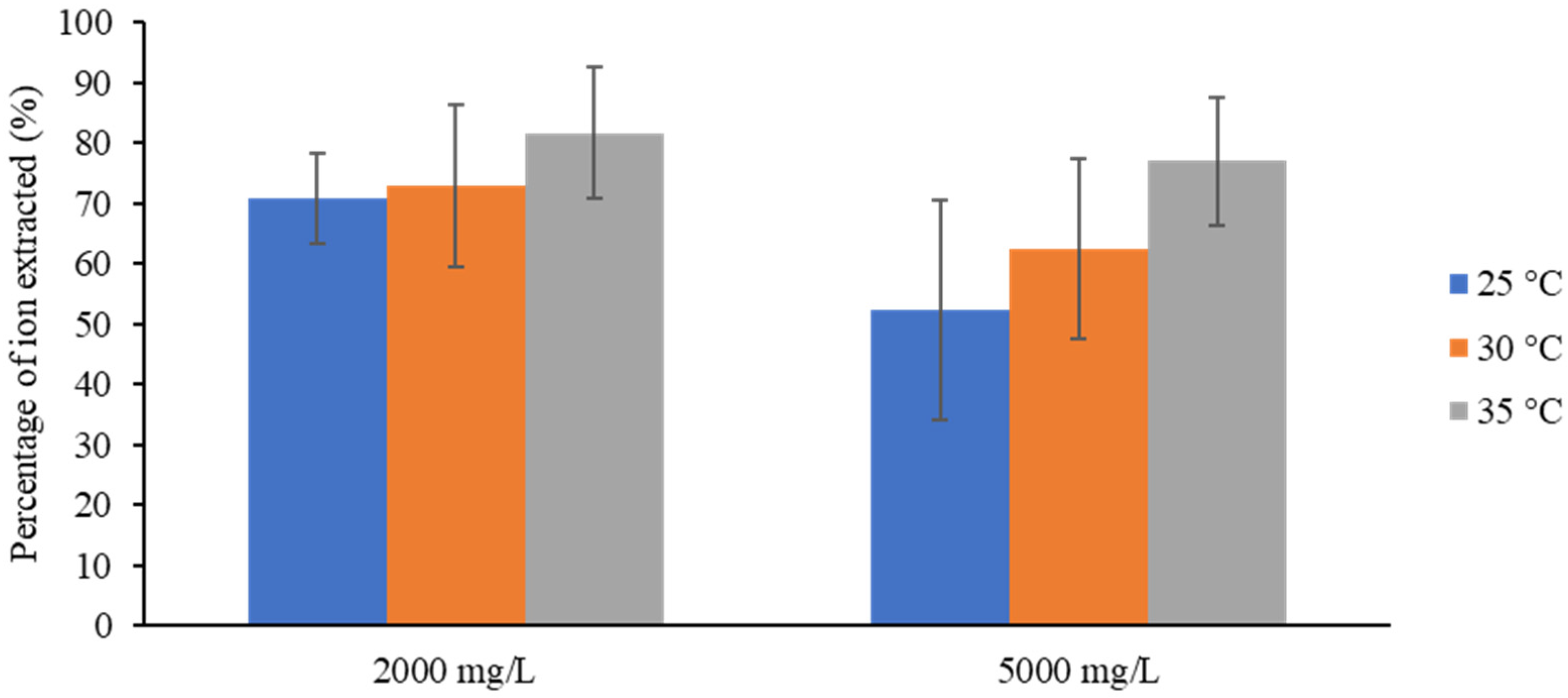
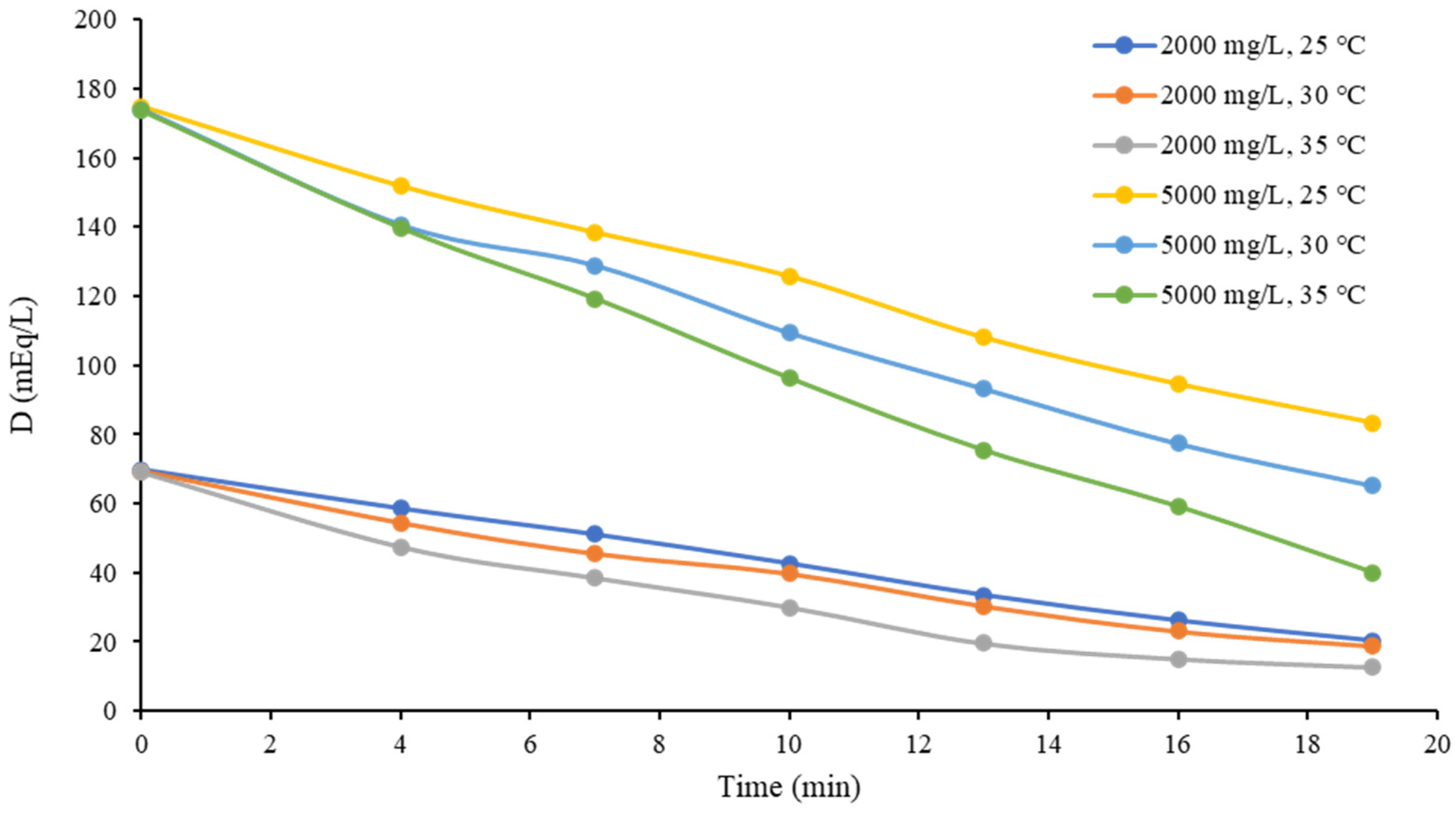
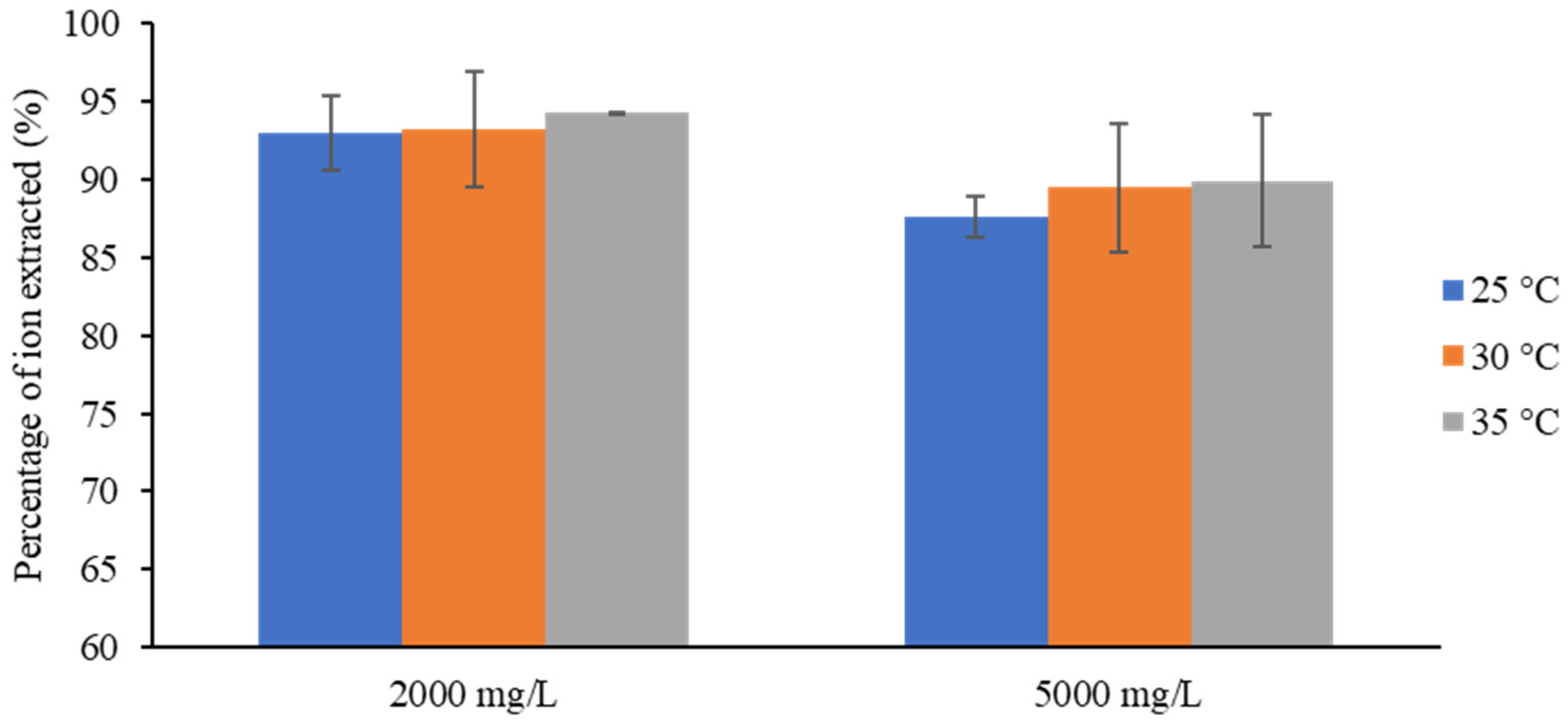
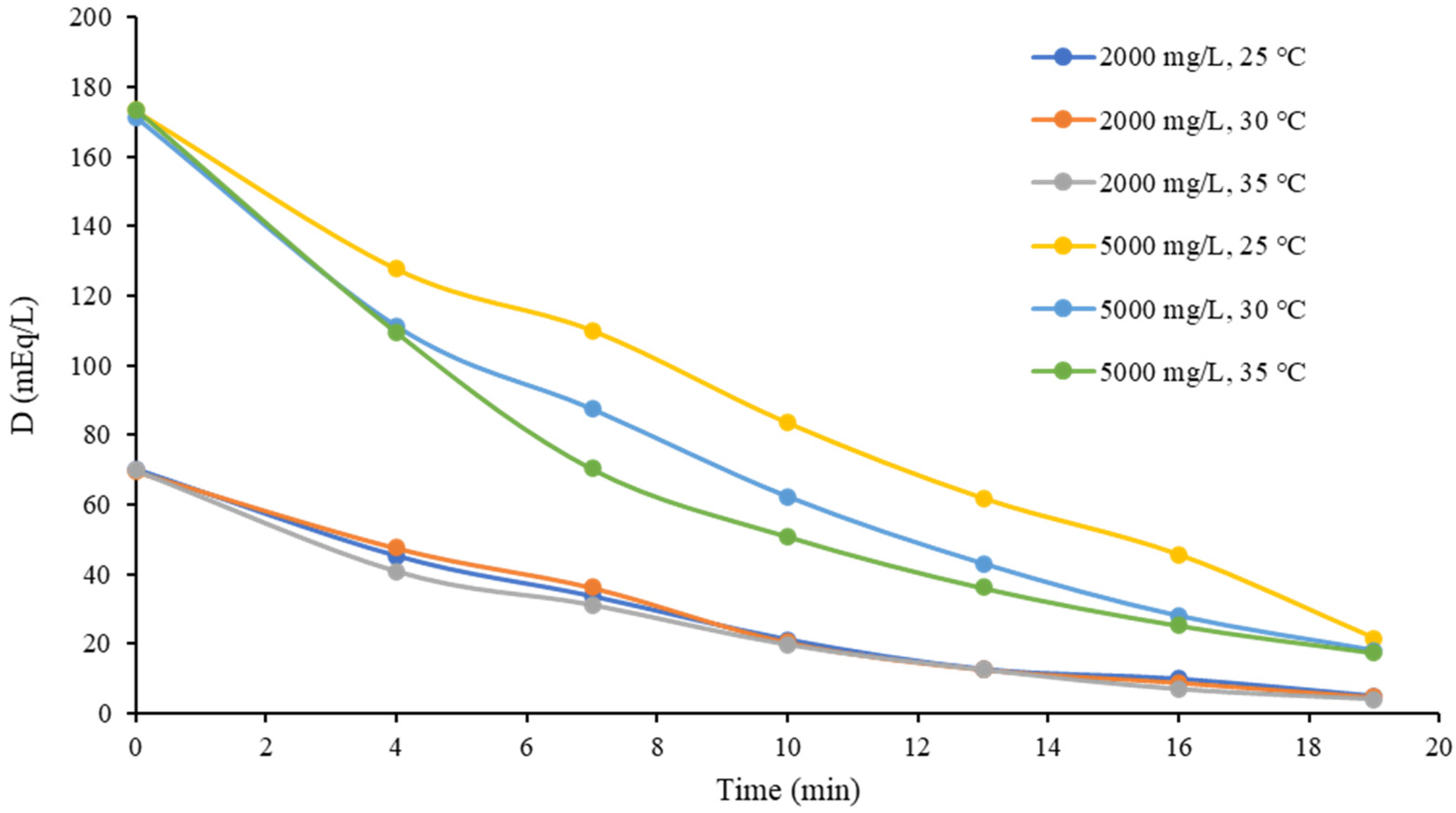

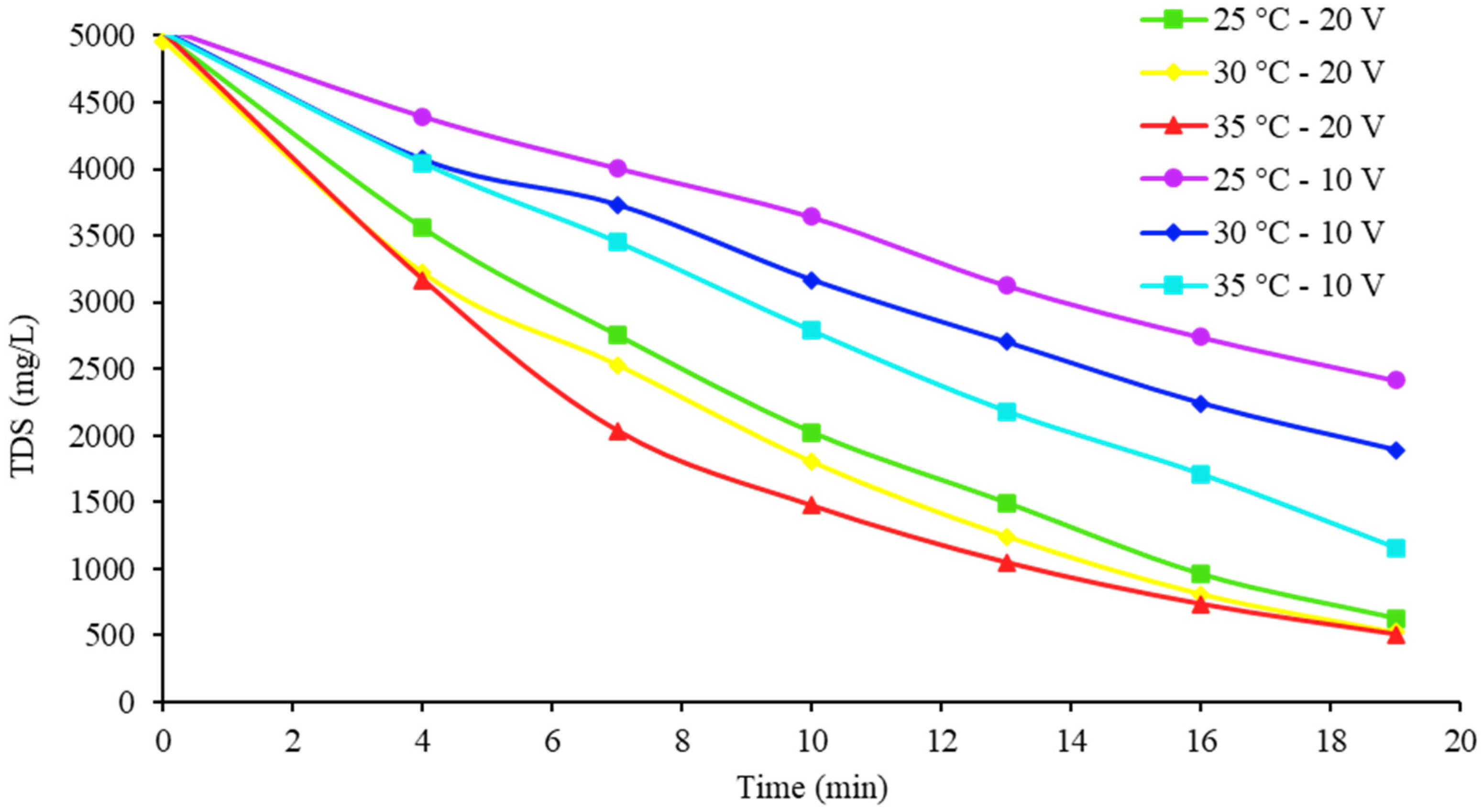
| Parameter | Value |
|---|---|
| Cell thickness (m) | 0.0015 |
| Cell height (m) | 0.180 |
| Cell width (m) | 0.0925 |
| Cell area (cm2) | 166.5 |
| Membrane thickness (m) | 0.020 |
| Membrane height (m) | 0.180 |
| Membrane width (m) | 0.0925 |
| Membrane area (cm2) | 166.5 |
| Sample | Time (min) |
|---|---|
| 1 | 4 |
| 2 | 7 |
| 3 | 10 |
| 4 | 13 |
| 5 | 16 |
| 6 | 19 |
| Parameters | Value |
|---|---|
| Volume (L) | 300 ± 0.2 |
| TDS (mg/L) | 638 ± 4.8 |
| pH | 8.19 ± 0.1 |
| Electrical conductivity (mS/cm) | 0.992 ± 0.007 |
| Temperature (°C) | 19.91 ± 1.3 |
| Time (min) | D10V/D20V | |||||
|---|---|---|---|---|---|---|
| 2000 mg/L | 5000 mg/L | |||||
| 25 °C | 30 °C | 35 °C | 25 °C | 30 °C | 35 °C | |
| 0 | 1 | 1 | 1 | 1 | 1 | 1 |
| 4 | 1.2949 | 1.1461 | 1.1632 | 1.1894 | 1.2657 | 1.2774 |
| 7 | 1.5169 | 1.2591 | 1.2366 | 1.2585 | 1.4761 | 1.6982 |
| 10 | 2.0142 | 1.9419 | 1.5237 | 1.5073 | 1.7604 | 1.8921 |
| 13 | 2.6384 | 2.3991 | 1.5687 | 1.7484 | 2.1750 | 2.0867 |
| 16 | 2.6498 | 2.5893 | 2.1753 | 2.0757 | 2.7732 | 2.3312 |
| 19 | 4.1216 | 3.9836 | 3.1438 | 3.8726 | 3.6304 | 2.2829 |
| Case | Arrangement | Ions Extracted (%) 10 V | Ions Extracted (%) 20 V | Difference (%) |
|---|---|---|---|---|
| 1 | 2000 SDT-25 °C | 70.84 ± 7.35 | 92.96 ± 2.38 | 22.13 |
| 2 | 2000 SDT-30 °C | 72.87 ± 13.45 | 93.19 ± 3.68 | 20.32 |
| 3 | 2000 SDT-35 °C | 81.67 ± 10.88 | 94.24 ± 0.11 | 12.56 |
| 4 | 5000 SDT-25 °C | 52.33 ± 18.25 | 87.57 ± 1.33 | 35.24 |
| 5 | 5000 SDT-30 °C | 62.51 ± 14.95 | 89.5 ± 1.25 | 27.01 |
| 6 | 5000 SDT-35 °C | 77.02 ± 10.62 | 89.92 ± 4.28 | 12.90 |
| Time (min) | D25°C–D35°C (mEq/L) | |||
|---|---|---|---|---|
| 2000 mg/L | 5000 mg/L | |||
| 10 V | 20 V | 10 V | 20 V | |
| 0 | 0 | 0 | 0 | 0 |
| 4 | 11.0773 | 4.4042 | 12.1228 | 18.2840 |
| 7 | 12.5120 | 2.4914 | 19.1520 | 39.7605 |
| 10 | 12.6233 | 1.4683 | 29.5547 | 32.5869 |
| 13 | 13.9693 | 0.2445 | 32.6684 | 25.6693 |
| 16 | 11.1218 | 2.9587 | 35.5453 | 20.2417 |
| 19 | 7.6962 | 0.9122 | 43.4715 | 4.0484 |
| Average | 11.5 | 2.08 | 28.7524 | 23.4318 |
| Feed Water | Diluate Water | Concentrated Water | Feed Water | Diluate Water | Concentrated Water | ||
|---|---|---|---|---|---|---|---|
| Cations (meq/L) | Anions (meq/L) | ||||||
| Ca | 1.19 | 0.07 | 2.05 | HCO3 | 0.14 | 0.01 | 0.23 |
| Mg | 5.66 | 0.32 | 9.69 | SO4 | 3.27 | 0.19 | 5.6 |
| Na | 27.04 | 1.55 | 46.37 | Cl | 31.47 | 1.81 | 53.95 |
| K | 0.59 | 0.03 | 1.01 | F | 0.01 | 0 | 0.01 |
| NH4 | 0.012 | 0 | 0 | NO3 | 0.01 | 0 | 0.02 |
| Ba | 0.018 | 0 | 0 | PO4 | 0.05 | 0 | 0.09 |
| Sr | 0.019 | 0 | 0 | B | 0.05 | 0 | 0.09 |
| Total | 34.52 | 1.97 | 59.12 | Total | 35 | 2.01 | 59.99 |
| Feed Water | Diluate Water | Concentrated Water | Feed Water | Diluate Water | Concentrated Water | ||
|---|---|---|---|---|---|---|---|
| Cations (meq/L) | Anions (meq/L) | ||||||
| Ca | 2.96 | 0.3 | 5.13 | HCO3 | 0.34 | 0.03 | 0.59 |
| Mg | 14.03 | 1.42 | 24.35 | SO4 | 8.11 | 0.82 | 14.04 |
| Na | 67.13 | 6.77 | 116.26 | Cl | 78.12 | 7.87 | 135.29 |
| K | 1.46 | 0.15 | 2.54 | F | 0.01 | 0 | 0.02 |
| NH4 | 0 | 0 | 0.01 | NO3 | 0.02 | 0 | 0.03 |
| Ba | 0 | 0 | 0 | PO4 | 0.12 | 0.02 | 0.21 |
| Sr | 0 | 0 | 0.01 | B | 0.14 | 0.01 | 0.13 |
| Total | 85.58 | 8.64 | 148.3 | Total | 86.84 | 8.76 | 150.18 |
| Arrangement | Heating (kWh) | Pump (kWh) | Rectifier (kWh) | |||
|---|---|---|---|---|---|---|
| 10 V | 20 V | 10 V | 20 V | 10 V | 20 V | |
| 2000 mg/L–25 °C | 0.08 | 0.08 | 0.0250 | 0.0260 | 0.0125 | 0.0214 |
| 2000 mg/L–30 °C | 0.13 | 0.13 | 0.0245 | 0.0253 | 0.0125 | 0.0214 |
| 2000 mg/L–35 °C | 0.22 | 0.22 | 0.0245 | 0.0253 | 0.0125 | 0.0214 |
| 5000 mg/L–25 °C | 0.16 | 0.16 | 0.0263 | 0.0263 | 0.0173 | 0.0312 |
| 5000 mg/L–30 °C | 0.24 | 0.24 | 0.0256 | 0.0257 | 0.0173 | 0.0312 |
| 5000 mg/L–35 °C | 0.38 | 0.38 | 0.0255 | 0.0255 | 0.0173 | 0.0312 |
| Arrangement | 10 V (kWh) | 20 V (kWh) | Increased Energy Consumption (%) |
|---|---|---|---|
| 2000 mg/L–25 °C | 0.1175 | 0.1274 | 8.42 |
| 2000 mg/L–30 °C | 0.167 | 0.1767 | 5.8 |
| 2000 mg/L–35 °C | 0.257 | 0.2667 | 3.77 |
| 5000 mg/L–25 °C | 0.2036 | 0.2175 | 6.83 |
| 5000 mg/L–30 °C | 0.2829 | 0.2969 | 4.95 |
| 5000 mg/L–35 °C | 0.4228 | 0.4367 | 3.29 |
| Arrangement | Production Energy Cost (USD/m3) | |
|---|---|---|
| 10 V | 20 V | |
| 2000 mg/L–25 °C | 0.52 | 0.66 |
| 2000 mg/L–30 °C | 0.51 | 0.65 |
| 2000 mg/L–35 °C | 0.51 | 0.65 |
| 5000 mg/L–25 °C | 0.61 | 0.80 |
| 5000 mg/L–30 °C | 0.60 | 0.79 |
| 5000 mg/L–35 °C | 0.59 | 0.78 |
Publisher’s Note: MDPI stays neutral with regard to jurisdictional claims in published maps and institutional affiliations. |
© 2021 by the authors. Licensee MDPI, Basel, Switzerland. This article is an open access article distributed under the terms and conditions of the Creative Commons Attribution (CC BY) license (https://creativecommons.org/licenses/by/4.0/).
Share and Cite
Dévora-Isiordia, G.E.; Ayala-Espinoza, A.; Lares-Rangel, L.A.; Encinas-Guzmán, M.I.; Sánchez-Duarte, R.G.; Álvarez-Sánchez, J.; Martínez-Macías, M.d.R. Effect of Temperature on Diluate Water in Batch Electrodialysis Reversal. Separations 2021, 8, 229. https://doi.org/10.3390/separations8120229
Dévora-Isiordia GE, Ayala-Espinoza A, Lares-Rangel LA, Encinas-Guzmán MI, Sánchez-Duarte RG, Álvarez-Sánchez J, Martínez-Macías MdR. Effect of Temperature on Diluate Water in Batch Electrodialysis Reversal. Separations. 2021; 8(12):229. https://doi.org/10.3390/separations8120229
Chicago/Turabian StyleDévora-Isiordia, Germán Eduardo, Alejandra Ayala-Espinoza, Luis Alberto Lares-Rangel, María Isela Encinas-Guzmán, Reyna Guadalupe Sánchez-Duarte, Jesús Álvarez-Sánchez, and María del Rosario Martínez-Macías. 2021. "Effect of Temperature on Diluate Water in Batch Electrodialysis Reversal" Separations 8, no. 12: 229. https://doi.org/10.3390/separations8120229
APA StyleDévora-Isiordia, G. E., Ayala-Espinoza, A., Lares-Rangel, L. A., Encinas-Guzmán, M. I., Sánchez-Duarte, R. G., Álvarez-Sánchez, J., & Martínez-Macías, M. d. R. (2021). Effect of Temperature on Diluate Water in Batch Electrodialysis Reversal. Separations, 8(12), 229. https://doi.org/10.3390/separations8120229








